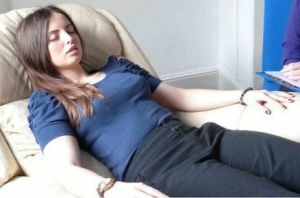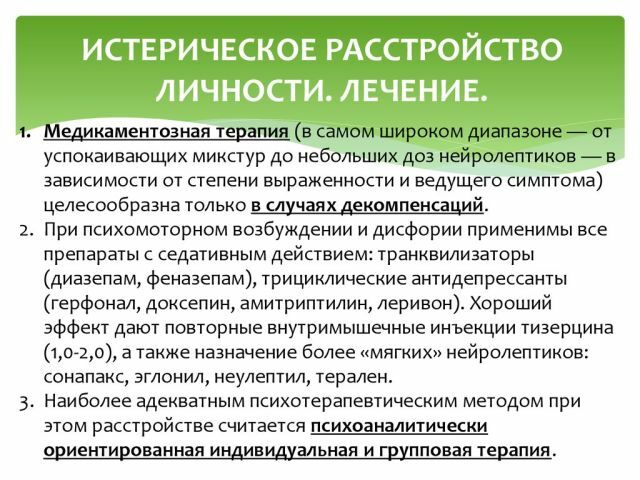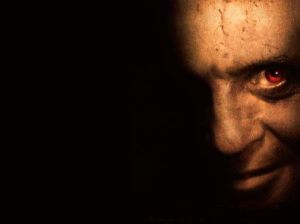 Delusional disorder( in the old terminology of paranoid psychosis) refers to a group of fairly serious mental illness, which is characterized by systematic nonsense.
Delusional disorder( in the old terminology of paranoid psychosis) refers to a group of fairly serious mental illness, which is characterized by systematic nonsense.
The danger consists in the appearance in man of the dominant ideas that have a false basis. With all this, a patient suffering from this violation is not able to distinguish between the real and the imaginary, which often leads to serious problems in life, up to its complete collapse.
Content
- General characteristics
- Contact delirium
- What is different from schizophrenia
- Factors and Risk
- nature of clinical
- complex disorders
- Diagnosis and differential diagnosis
- disease organic nature
- chronic delusional disorder
- induced form
- violations Other syndromes delusional spectrum
- RenderingHelp
- Is there a danger to the patient and others?
General description
Delusional disorder is a serious mental illness, a psychosis accompanied by a persistent presence in a person of systematized delirium with a dominant bias and an absolute, unshakable belief in the available false beliefs. Previously, a group of these diseases was called paranoid psychosis.
The basis for delusions are most often life moments that a person is not able to adequately perceive. Due to incorrect interpretation of experience or perception, the picture in the head is distorted, but in reality the situations experienced are often not truthful or exaggerated.
The danger of the state lies in the frequent immersion in obsessive delirium so that other aspects of life recede into the background.
The individual tries to solve a non-existent problem, believing that it really does have a place to be. For this reason, real life often begins to collapse and it can sometimes be difficult to restore it, if not impossible.
It is believed that paranoid nonsense as an independent deviation is rare. Most often it is an accompanying symptom of other, more severe deviations.
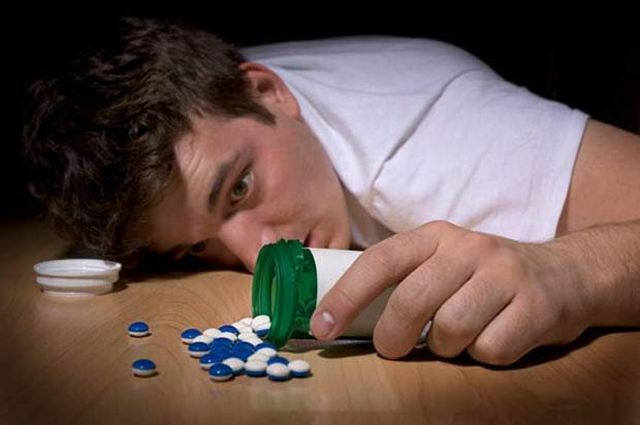
Relationship with delirium
Delirium is a disorder of thinking, manifesting in an unshakable conviction of certain inferences, reasonings and conclusions that do not correspond to reality. It is the dominant characteristic of delusional disorder, in other words, the theme of the disorder.
It is on the strength of strengthening the belief in false thoughts that are formed that psychosis and the further line of human behavior are formed.
What is different from schizophrenia
A distinctive feature of paranoid psychosis can be called a high degree of probability of development in life of those situations that initially arise only in the head of the patient.
All kinds of ideas that visit a person in this state differ in the appearance of reality and are devoid of a touch of quirkiness, which makes one even more believe that everything is really happening.
The main difference from schizophrenia is that people with unreal obsessions are sociable, active, socially adequate, sociable, able to function and solve a problem that differs from the dominant delirious idea. Their behavior does not always indicate the presence of psychosis, because the actions are not characterized by obvious  eccentricity or any strangeness.
eccentricity or any strangeness.
In the case of schizophrenic patients, confusion of emotions, loss of sensation and understanding of reality are observed, in general, inadequate behavior is observed. The patient hears voices, sees pictures that can not exist in real life.
Schizophrenia requires custody of the patient, because in such a state the patient is often asocial and often poses a threat to themselves and others.
Factors and risk groups
The exact reasons that influence the development of delusional ideas have not been revealed to this day, but in spite of this experts distinguish three main theories on which modern psychiatry relies:
- Psychological factor - unfavorable environment conditions that cause stress become a provocateur of the disease.
- Genetic factor .It was revealed that most often paranoid psychosis occurs in people whose relatives have been subjected to some kind of mental disorders. Experts believe that the predisposition is passed from parents to children.
- Biological factor .The relationship between certain pathologies of certain brain zones and the development of delusional psychosis has been revealed. Also, the effect of imbalance neurotransmitters in the brain, which perform the function of transmitting messages between nerve cells.
In addition to these factors, at-risk groups are people who abuse alcohol, take drugs, are isolated from society or suffer from loneliness. It was also noted that diseases of the delusional spectrum are more common in old age and women are more exposed to it than men.
Nature of the clinical picture
The main characteristic of the clinical picture of delusional disorder is the frequent expression of delusions in the patient. At the same time, the character of a person's ideas is purely personal, not a general one.
Symptoms can also be: 
- depression;
- irritation;
- anger;
- mood swings;
- hallucinations, corresponding to a specific type of delirium.
In each case, the clinical picture will be different. It all depends on the nature of delusions of a particular individual.
Complex of violations
Delusional personality disorder can manifest itself in various forms, it all depends on the theme of the underlying idea.
Basic types of paranoid psychosis:
- Persecution-based delusion .There is a painful mistrust and suspicious attitude to others. It seems to the person that they are hunted for, they want to do harm, conspiracies are being built against him, discussing and condemning him.
- Hypochondriacal disorder .Characterized by the patient's conviction that he has any serious diseases - cancer,
 tuberculosis. Often there are thoughts that something is wrong with the body - there is parasite infection, rotting of internal organs.
tuberculosis. Often there are thoughts that something is wrong with the body - there is parasite infection, rotting of internal organs. - Mania of greatness .In this case, a person is convinced that he has any incredible features and talents that are not recognized by others. It can be a belief in family ties with celebrities or high-ranking persons, conviction of one's own genius and talent. In some cases, the patient believes that he is able to save the world from some impending disaster or that he made a discovery, but no one noticed it.
- Violation based on delirium jealousy .There are unjustified attacks of jealousy in the absence of signs of betrayal. The patient can arrange a lengthy interrogation, surveillance and constantly try to find out the circumstances of non-existent treason, flirting or other manifestations of dishonesty partner.
- Erotic mania .The patient is convinced that some famous person is in love with him.
- A mixed type of violation is often encountered. In this case, a person has ideas associated with several areas of delusions.
Diagnostics and differential diagnostics
Diagnostics is based on the degree of compliance with the following criteria:
- Observation of a certain delusional idea for at least 3 months;
- the presence of delirium, not characteristic of schizophrenia;
- no signs and eccentricities of behavior typical of schizophrenia;
- no permanent hallucinations, except for rare auditory deceptions that do not manifest themselves as commentators of the patient's actions;
- no abnormalities caused by taking psychotropic medications.
Differential diagnosis primarily requires the exclusion of such diseases:
- is a paranoid personality disorder;
- paranoid schizophrenia with delirium, characterized by quirkiness, absurdity, and also manifested in hallucinations, a disorder of thinking;
- other acute delusional syndromes.
Exclusion of delusional syndromes based on organic brain lesions is also required. Similar symptoms can be observed in traumas or tumors in various areas of the brain.
Organic Disease
Organic delusional disorder manifests itself in permanent or appearing periodically false beliefs that are dominant in the overall picture. Quite often there are symptoms similar to schizophrenia - eccentric nonsense, disturbance of thinking, hallucinations.
There are 2 forms of this form of disorder:
- acute , arising on a background of a craniocerebral trauma or other abrupt violation and characterized by sudden psychopathological symptoms;
- chronic , where the feature is the slow, irreversible course of the disease.
A distinctive feature of the organic form of the syndrome is its development due to genetic predisposition or damage to brain structures.

Chronic delusional disorder
A group of abnormalities that are not schizophrenic, affective or organic. There are 3 main forms of the disease:
- Paranoid syndrome .For the disorder is characterized by a long-running orderly delirium on a certain topic. In this case, there are no signs of dementia, hallucinations, a person does not have internal contradictions. Those who surround such people seem quite normal.
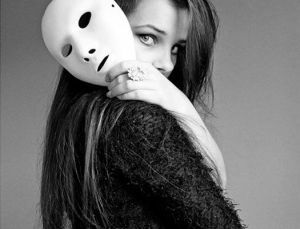
- Paranoid syndrome .In this case, there is also a systematized delusion, but there are already some deviations that do not fit into the general picture. Often in the person's head there are voices commenting on his behavior.
- Paraphrenia .The syndrome manifests itself in the form of pronounced fantastic delirium. A distinctive feature is often the occurrence of false memories and pseudo-hallucinations. This species is characterized by a constant display of delirium for at least 3 months.
Induced form of disorder
Induced delusional disorder manifests itself in the division of delusional conclusions by several persons linked by emotional ties. Most often a kind of movement, whose members agree, support and glorify the thoughts and reasoning of the founder.
The inductor most often suffers from megalomania, persecution, hypochondriac delirium can be observed. At the same time, recipients do not realize that they listen to a person with obvious signs of psychosis, enter into emotional ties with him and lose their own distinctive features.
It's interesting that an inductor can be a mentally healthy person, leading a recipient into a psychotic state.
In addition, the delusional-ideological symptomatology can manifest itself in the case if in one territory with the patient live close to him people.
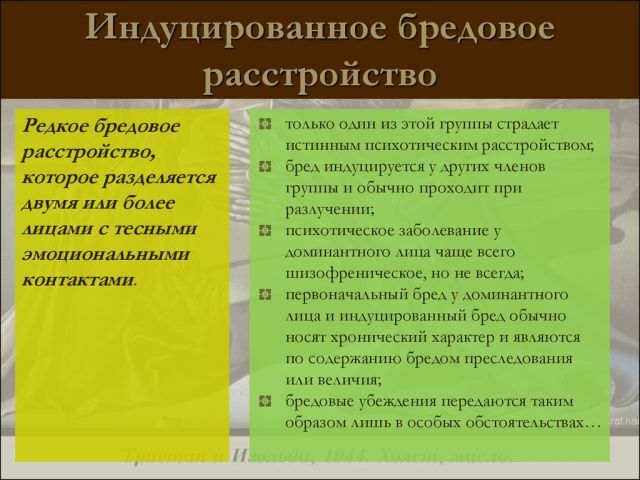
Other syndromes of delusional spectrum
This group of diseases is understood as the presence of individual manifestations of schizophrenia or chronic delirium, which are not characteristic of either, for the other in full measure.
This group is most often referred to as:
- Delusional form of dysmorphophobia .The patient is convinced that there is any defect on his body with a focus on it.
- Querulant or tart disorder .A person is passionately and with unhealthy soreness struggles for any idea - he writes complaints and letters to various instances.
- is also allocated as a separate form to the involutional paranoid .Most often manifested in the elderly, after 60 years. It is in the wrong and often in an aggressive interpretation of the man's relationship with his loved ones. It may seem to a person that relatives want to rob him, poison him and even kill him.
Assistance with
Treatment of delusional disorders involves a comprehensive approach, including medication and psychotherapeutic measures. The latter consist in transferring the patient's attention from the subject of delirium to the real sides of life. There are several areas of psychotherapy:
- individual;
- family;
- is cognitive-behavioral.
 Most often, doctors use methods of cognitive-behavioral psychotherapy, which allows them to identify thoughts that cause anxiety to the patient and change their course.
Most often, doctors use methods of cognitive-behavioral psychotherapy, which allows them to identify thoughts that cause anxiety to the patient and change their course.
Treatment with medications is primarily based on the administration of neuroleptics. If the patient shows signs of depression, oppression, then specialists prescribe antidepressants or tranquilizers. Running forms of delusional ideas require hospitalization of the patient until the moment of complete cure.
Is there a danger to the patient and others?
The prognosis and consequences depend on the type of personality, the type of delusional disorder, the form of its course. An important role is played by support of relatives and the general life situation of a person.
Most often the disease has a chronic course, but with full and competent treatment, some patients are able to completely get rid of the psychosis. In other cases, periods of exacerbations are likely, but the timely use of prescribed medications can significantly alleviate this condition.
If the idea of delusions is not treated, it is possible that after a while a person completely immersed in the world of his delusional ideas and his real life, as well as links with family and loved ones will fail.
Paranoid psychoses most often do not pose a threat to life, but the lack of professional help can lead to chronic forms and complexities in real life. Noticing the signs of psychosis in loved ones, it is worth paying close attention and helping an expensive person, as identifying the disease on its own is quite difficult.

